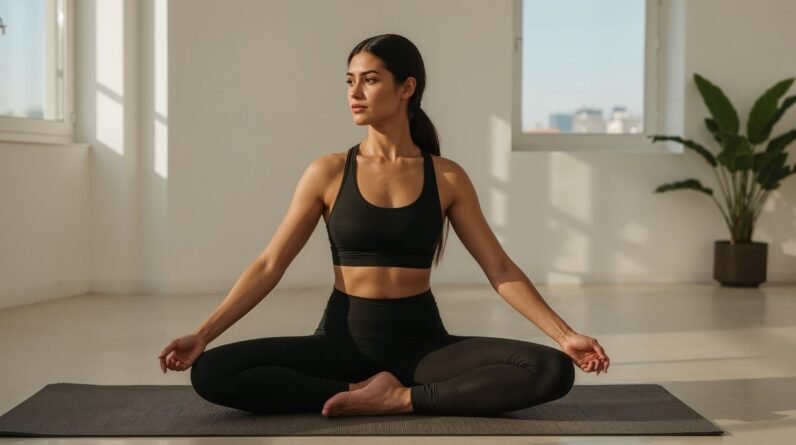
Practising yoga every morning comes with a lot of benefits. Check out some of the best early-morning yoga poses to begin your day with.
In the daily chaos of hurried morning routines, quick baths and on-the-go breakfasts, we often yearn for a few moments of peace. All you need to do, to get this is, to wake up an hour earlier and practice yoga. While taking out this time might seem challenging at first, soon you will begin to notice the advantages of early morning yoga poses. Not only do these help in setting a rather peaceful and calm start to your day, but these poses help in keeping anxiety and stress at bay. Also, our bodies are stiff in the morning, and these poses can help enhance flexibility. Wondering which morning yoga poses to start with, check out an easy routine below.
Is it healthy to do yoga early morning?
Yes, two hours before and after sunrise is the best time to practice yoga as this is the peak time for Satvik Energy. “Practicing early morning yoga poses on a daily basis sets your entire day as your mind, body and soul align with the nature around,” explains yoga expert Khushboo Shukla. Yoga helps wake up your body and mind, improving blood circulation and oxygen flow. This keeps you energised and focused throughout the day.

5 benefits of morning yoga poses
Early morning yoga poses help you set a rhythm to your day. Here is how this helps you:
1. Starts your day on a positive note
Early morning Yoga practice increases the positivity in and around. Meditation, which can be done in the morning as part of a yoga routine, stimulates the mind to come up with new creative ideas, states a study, published in the journal Science Daily. This is why you can see a clear difference in your entire day when you do morning yoga poses.
2. Health benefits and time management
You don’t have to worry about taking time for a workout once you practice morning yoga poses. These are enough to help you stay fit. If you get consistent pain due to longer working hours, warming up the body in the morning will keep the aches away, explains Shukla. The other health benefits of early morning yoga poses are that they help in sharpening your memory, and also reduce chances of anxiety and depression during the day, states this study, published in the International Journal of Yoga.
3. Increased Prana or life force
If you do early morning yoga poses regularly, your life force and energy goes to another level. This is especially when you you practice Pranayama early morning. Make sure to do this with no noise around as you will be able to focus on your breath more. Deep breathing helps in reducing stress and increasing the life force energy within, states this study, published in the journal Neurological Sciences.
4. Enhances flexibility and regulates hormones
Other benefits of early morning yoga poses include their ability to help make your body more flexible. Your body may feel stiff after sleeping, and morning yoga helps loosen up tight muscles and joints. Certain yoga poses may also help to stimulate the endocrine system, helping balance hormones, improve digestion, and boost metabolism.
5. Improves digestion
Morning yoga stimulates the digestive system. This helps give you better gut health. Additionally, early morning yoga poses also help to detoxify the body.
Early morning yoga poses for good health
Looking to start early morning yoga poses? Here is an easy regime that you can follow
You may also like


1. Sukshma Vyayam:
A warm-up for joints is very important to start with. In this you can focus on the following exercises:
Neck rotation:
- Sit or stand comfortably with a straight back.
- Slowly rotate your neck clockwise and then counterclockwise (5 times on each side).
- Keep movements slow and controlled to avoid strain.
Shoulder rotation:
- Lift your shoulders toward your ears and rotate them forward and backwards (5 times each).
Wrist rotation:
- Extend your arms forward, make fists, and rotate your wrists clockwise and counterclockwise (5 times each).
Elbow bending:
- Stretch your arms forward, then bend your elbows and touch your shoulders.
- Straighten again and repeat 10 times.
- Strengthens arms and improves flexibility.
Side bending:
- Stand with feet apart, raise one arm, and bend sideways.
- Hold for a few seconds and repeat on the other side (5 times each).
Knee rotation:
- Stand with knees slightly bent, place hands on your knees, and rotate them clockwise and counterclockwise (5 times each).
You can also practice jogging or jumping for one to two minutes. Make sure to sit comfortably, take deep breaths, and relax for a few minutes.
2. Tadasana (Mountain Pose)
- To to Tadasana, stand straight with your feet together or slightly apart (hip-width for balance). Keep your spine straight and distribute weight evenly on both feet. Place your hands alongside your body with palms facing inwards.
- Inhale deeply and slowly raise both arms overhead. Interlock your fingers and turn your palms upward, facing the sky. Keep your arms straight and stretch them as much as possible.
- Slowly lift your heels off the ground, standing on your toes. Stretch your entire body upward, feeling the pull from your toes to your fingertips.
- Engage your core and keep your gaze straight ahead or slightly upward. Stay in this position for 30 seconds to 1 minute, breathing normally. Maintain balance and feel the full-body stretch from head to toe.
- Exhale slowly and lower your heels back to the ground. Bring your arms down and relax in a normal standing position.
- Repeat the pose 2-3 times for maximum benefits.
3. Triyak Taadasana (Swaying Palm Tree pose)
- Stand straight with your feet shoulder-width apart. Keep your spine erect, shoulders relaxed, and gaze forward. Place your hands alongside your body with palms facing inwards.
- Inhale deeply and raise both arms overhead. Interlock your fingers, keeping the palms facing upward. Stretch your entire body upward, feeling the elongation in your spine.
- Exhale slowly and bend your upper body to the right side, keeping your arms straight. Avoid bending forward or backward—focus on a side stretch.
- Hold the stretch for 15–30 seconds while breathing normally. Inhale and come back to the centre.
- Exhale and bend your upper body to the left side. Feel the stretch on the opposite side of your waist. Hold for 15–30 seconds, breathing normally.
- Inhale and return to the centre. Exhale and slowly bring your arms down. Relax and take a few deep breaths. Repeat the cycle 3–5 times.
4. Vrikshasana or Tree pose
- Stand straight with your feet together and arms at your sides.
- Shift weight onto your left foot, keeping it firm on the ground.
- Place your right foot on your left inner thigh (above or below the knee, not on it).
- Balance and bring your palms together in Namaste at your chest or overhead.
- Hold for 15–30 seconds, breathing deeply and focusing on a point.
- Slowly lower your right leg, and return to the starting position.
- Repeat on the other side.
5. Marjariasana or Cat pose
- Start in a tabletop position (wrists under shoulders, knees under hips).
- Inhale as you lift your head, arch your back, and push your tailbone up
- Exhale as you tuck your chin to your chest, round your spine, and pull your belly in.
- Repeat the movement smoothly for 5–10 rounds, syncing breath with motion.
6. Ushtrasana or Camel pose
- Kneel on the mat with knees hip-width apart and hands on your lower back.
- Inhale as you lift your chest and arch your back.
- Exhale and reach your hands back to hold your heels, keeping your hips forward.
- Drop your head back gently, opening the chest and stretching the spine.
- Hold for 20–30 seconds, breathing deeply.
- Inhale to come up slowly and relax
7. Parvatasana or Mountain pose
- To do Parvatasana, start in Vajrasana (sitting on heels) with a straight spine.
- Inhale as you raise both arms overhead, palms joined in Namaste.
- Stretch upwards, keeping the arms and back straight.
- Hold for 20–30 seconds, breathing deeply.
- Exhale – Lower arms slowly and relax.
8. Shashankasana or Rabbit pose
- Sit in Vajrasana (knees together, sitting on heels).
- Inhale as you raise both arms overhead.
- Exhale as you bend forward, bringing the forehead to the floor and arms stretched forward.
- Relax, keeping the hips on the heels. Breathe deeply.
- Hold for 20–30 seconds, then slowly return to Vajrasana.
9. Sukhasana or Easy pose for Pranayama
- Sit comfortably cross-legged on the floor with a straight spine.
- Rest your hands on your knees in Gyan Mudra (thumb and index finger touching).
- Close your eyes and relax your shoulders.
- Breathe deeply through the nose, maintaining a steady rhythm.
- Focus on your breath and practice pranayama techniques like Anulom Vilom or Bhramari.

10. Close with 11 or 21 times Om chanting
Chanting Om after morning yoga poses has several benefits. It helps to calm the mind and relax your body. It reduces stress, helping you get a peaceful start to your day. The vibrations of om synchronise your breath with your body’s energy, helping in better oxygen circulation. Just as a warm-up is essential before yoga, Om chanting acts as a closure, allowing the mind and body to absorb the benefits of the session.
- Sit in Sukhasana (cross-legged) or Padmasana (lotus pose) with a straight spine.
- Rest your hands on your knees in Chin Mudra (thumb and index finger touching, palms facing up).
- Close your eyes and take a few deep breaths. Inhale deeply through the nose.
- Feel your breath filling your lungs, preparing for the chant.
- As you exhale, chant Om slowly
Therefore, we see that praciing early morning yoga poses can help in aligning our mind, body, and soul with nature’s rhythm. It goes a long way in enhancing flexibility, improving digestion as well as regulating hormones. By incorporating early morning yoga poses into your daily routine, you set a positive tone for the day, increase your energy levels, and build mental clarity.







